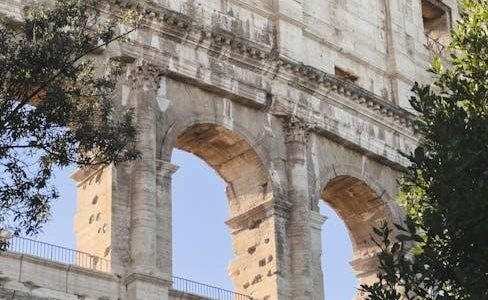Deuteronomy provides a unique perspective on Passover‚ emphasizing its theological significance and communal observance. It reiterates the Exodus narrative‚ highlighting redemption and covenant renewal. The book adapts Passover instructions for a new generation‚ ensuring its traditions endure as a memorial to God’s deliverance.
1.1 Historical Context of Deuteronomy’s Passover Instructions
The Passover instructions in Deuteronomy are rooted in the broader narrative of the Israelites’ journey and the covenant with God. Historically‚ Deuteronomy is part of the Deuteronomistic History‚ which includes books like Joshua‚ Judges‚ Samuel‚ and Kings‚ suggesting it was compiled later‚ possibly during the reign of King Josiah in the 7th century BCE. This context implies that Deuteronomy’s Passover instructions were addressed to a new generation of Israelites who were about to enter the Promised Land‚ unlike the generation that experienced the Exodus. The book serves as Moses’s farewell speech‚ reinterpreting earlier traditions like Passover for a new audience. Notably‚ Deuteronomy 16 centralizes Passover worship in “the place that the Lord your God will choose‚” reflecting the centralization of worship during Josiah’s reforms. This centralization aligns with the broader themes of Deuteronomy‚ emphasizing covenant obedience‚ purity‚ and the removal of leaven‚ which symbolizes sin. Thus‚ Deuteronomy’s Passover instructions adapt the original Exodus narrative to suit the evolving needs of the Israelites as they transitioned from a nomadic people to settlers in Canaan‚ emphasizing unity and centralized worship.

Key Passover Instructions in Deuteronomy
Deuteronomy emphasizes centralizing Passover in the place God chooses‚ removing leaven‚ and ensuring communal participation. It adapts earlier traditions‚ focusing on unity and covenant renewal‚ while maintaining the essence of the Exodus story and its theological significance.
2.1 Theological Significance of Passover in Deuteronomy
The theological significance of Passover in Deuteronomy lies in its emphasis on redemption‚ covenant renewal‚ and divine sovereignty. Deuteronomy frames Passover as a commemoration of Israel’s deliverance from Egypt‚ symbolizing God’s faithfulness and the people’s obligation to obey His commands. Unlike Exodus‚ Deuteronomy adapts the Passover instructions to emphasize communal observance and unity‚ reflecting a shift from a familial to a national ritual. The removal of leaven and the consumption of unleavened bread are seen as acts of purification and humility‚ underscoring the moral and spiritual dimensions of the celebration. Deuteronomy also highlights Passover as a teaching moment‚ ensuring that future generations understand the Exodus story and their identity as God’s chosen people. This theological framework reinforces the covenantal relationship between God and Israel‚ making Passover a central pillar of Jewish identity and worship. By centralizing Passover in the place God chooses‚ Deuteronomy strengthens the connection between worship‚ community‚ and the land‚ embedding it deeply within Israel’s religious and cultural fabric.

Rituals and Practices
Deuteronomy outlines key Passover rituals‚ including the Passover lamb‚ removal of leaven‚ and communal celebration. These practices symbolize redemption‚ purity‚ and obedience‚ reinforcing Israel’s covenant with God and their identity as His people.
3.1 The Passover Lamb
The Passover Lamb holds profound significance in Deuteronomy‚ symbolizing redemption and divine protection. Instructions specify selecting a lamb without blemish and slaughtering it at twilight‚ mirroring Exodus. The lamb’s blood marked homes‚ sparing the Israelites from the tenth plague; Deuteronomy emphasizes communal participation‚ ensuring all partake in the ritual. The lamb represents purity and obedience to God’s commands‚ reinforcing Israel’s covenant. Centralized worship is stressed‚ requiring the lamb’s slaughter at the designated place‚ highlighting unified religious practice.
3.2 Removal of Leaven
Deuteronomy strongly emphasizes the removal of leaven during Passover‚ linking it to purity and obedience. Leaven symbolizes sin and pride‚ necessitating its complete eradication from homes. The instructions outline a thorough search and removal process‚ reflecting the seriousness of the command. This practice not only commemorates the haste of the Exodus but also serves as a spiritual reminder to eliminate sin from one’s life. The absence of leaven ensures a focus on humility and faith‚ aligning with the broader themes of covenant renewal and divine deliverance. The community’s collective effort in this ritual strengthens unity and shared commitment to God’s laws. Deuteronomy’s focus on leaven removal underscores the enduring importance of these practices in maintaining spiritual and communal integrity.

Observance in Deuteronomy
Deuteronomy emphasizes the annual observance of Passover as a communal celebration of liberation. It mandates gathering at the sanctuary‚ ensuring collective participation. The instructions reinforce the ritual’s purpose: to remember God’s deliverance and honor the covenant‚ fostering unity and obedience among the people.
4.1 Passover as a Memorial
Passover in Deuteronomy is deeply rooted in the concept of remembrance‚ serving as a perpetual memorial to God’s redemption of Israel from Egypt. The instructions emphasize that the festival is not merely a historical commemoration but a living tradition that connects each generation to the divine deliverance. Through its rituals‚ such as eating unleavened bread and holding a sacred assembly‚ Passover ensures that the Exodus narrative remains central to Israel’s identity. This emphasis on memory reflects Deuteronomy’s broader theme of covenant renewal‚ where the past informs the present and shapes the future.
The memorial aspect of Passover also underscores its role in fostering communal unity and faith. By reenacting the Exodus through symbolic acts‚ the Israelites reaffirm their commitment to God’s covenant. Deuteronomy’s instructions ensure that Passover becomes a shared experience‚ bridging the gap between past and present‚ and reinforcing the people’s obligation to honor God’s redemption. This focus on remembrance highlights Passover’s enduring significance as a cornerstone of Jewish tradition and identity.
4.2 The Role of the Community
In Deuteronomy‚ the observance of Passover is deeply tied to the collective participation of the community‚ emphasizing unity and shared responsibility. The instructions stipulate that all Israelites‚ including men‚ women‚ children‚ and even strangers within their gates‚ should gather to celebrate the festival. This inclusivity underscores the importance of communal identity and the covenantal bond between God and His people. The community’s role extends beyond individual observance; it involves shared rituals‚ such as eating the Passover meal together and recounting the Exodus story‚ which fosters a sense of solidarity and continuity across generations.
Deuteronomy also highlights the community’s responsibility to ensure that no one is excluded from participation. The poor‚ the stranger‚ and even servants are explicitly included in the instructions‚ reflecting a commitment to equity and justice. Furthermore‚ the community serves as a repository of tradition‚ passing down the meaning and significance of Passover to younger generations. This communal dimension ensures that Passover remains a vibrant and unifying force‚ reinforcing the people’s connection to their history and their covenant with God.
Passover in the Wider Biblical Context
Passover holds a central place in the broader narrative of the Bible‚ transcending its specific instructions in Deuteronomy. Originating in Exodus 12‚ Passover commemorates the Israelites’ liberation from Egyptian bondage through the sparing of their firstborn sons. This event is deeply rooted in the covenant between God and His people‚ symbolizing redemption and divine deliverance. Beyond Deuteronomy‚ Passover is referenced in other biblical books‚ such as Leviticus and Numbers‚ which provide additional rituals and regulations for its observance. The festival’s significance extends into the New Testament‚ where it is linked to the crucifixion of Jesus Christ‚ often referred to as the “Passover Lamb‚” who sacrificed Himself for the redemption of humanity.
Throughout the Bible‚ Passover serves as a unifying theme‚ reminding the people of God’s faithfulness and their identity as a redeemed community. Its observance evolves over time‚ adapting to the Israelites’ transition from wilderness wanderers to settled inhabitants of the Promised Land. Passover becomes a cornerstone of Jewish tradition‚ reinforcing the covenantal bond and the memory of divine deliverance. Its theological richness and historical depth make it a pivotal event in the biblical story‚ connecting past‚ present‚ and future.

Challenges in Observing Passover
Observing Passover as outlined in Deuteronomy presents several challenges‚ both historical and contemporary. One major challenge is adhering to the strict dietary laws‚ particularly the removal of all leaven from homes‚ which requires meticulous preparation and attention to detail. Additionally‚ the requirement to sacrifice the Passover lamb at a centralized location‚ such as Jerusalem‚ posed logistical difficulties for those living far from the Temple during biblical times.
Another challenge lies in understanding and applying the theological nuances of Passover in a modern context. Deuteronomy emphasizes the festival as a communal celebration‚ which can be difficult to maintain in dispersed or fragmented communities. The text also highlights the importance of educating future generations about the significance of Passover‚ requiring ongoing efforts to preserve its traditions and meanings.
Historically‚ the destruction of the Temple in 70 CE eliminated the possibility of sacrificing the Passover lamb‚ forcing Jewish communities to adapt rituals and focus more on symbolic practices‚ such as the Seder meal. These changes‚ while necessary‚ have introduced new layers of complexity in observing Passover faithfully according to its original instructions in Deuteronomy.
The instructions regarding Passover in Deuteronomy serve as a cornerstone for understanding the festival’s theological and historical significance. By reiterating the Exodus narrative‚ Deuteronomy emphasizes Passover as a celebration of liberation and divine covenant. The text underscores the importance of communal observance‚ education‚ and the symbolic removal of leaven‚ ensuring the festival remains a vivid reminder of God’s redemption.
Deuteronomy’s adaptation of Passover instructions for a new generation highlights the festival’s enduring relevance. While challenges such as dietary restrictions and theological interpretation persist‚ the core message of Passover remains unchanged. It is a call to remember‚ reflect‚ and renew one’s commitment to faith and community.
Ultimately‚ Passover in Deuteronomy is not just a historical ritual but a living tradition that bridges past and present. Its instructions continue to guide believers in honoring God’s deliverance while fostering unity and spiritual growth across generations.



